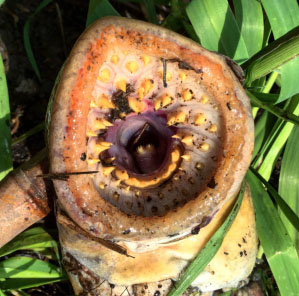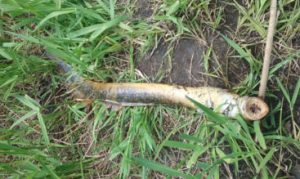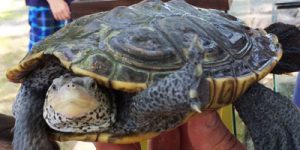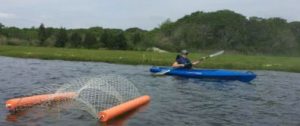This past May, a dead adult sea lamprey was observed at Oliver Mill Park in Middleborough. The fish had migrated up the river to spawn on the Nemasket and having completed its life cycle, died and was washed up on the banks. It was 30” long.
There are two lamprey species native to Massachusetts waters, the American Brook Lampry (Lethenteron appendix) (which is a threatened population in the state) and the Sea Lamprey (Petromyzon marinus).
The fellow found on the Nemasket was a Sea lamprey with its typical yellow spawning pigmentation. Sea lampreys are anadromous, they migrate from the ocean to freshwater to spawn. Sea Lampreys, when they enter the fresh water rivers to spawn, stop feeding, as all their energies are focused on reproduction, so they are not a threat to inland fisheries (like in the Great Lakes region, where Sea Lamprey predation have had a huge impact on restoring local fisheries.) Young lamprey can remain in freshwater for to five years living on the bottom as filter feeders. It is only in maturity, that the lamprey become parasitic, returning to the ocean and live for two years feeding off of other fish species fluids and tissues before returning to fresh water systems to spawn and then die.
There have been some studies of the Sea Lamprey populations in the Connecticut River Watershed. The fact that Sea Lampreys are present in the Taunton River watershed is an indication of the river system’s improving health.
Link to Mass Div. of Fisheries & Wildlife fact sheets on Sea Lamprey:
https://www.mass.gov/eea/agencies/dfg/dfw/fish-wildlife-plants/fish/petromyzon-marinus-2015.pdf


 The TRWA is pleased to announce it will be funding a technician to formally investigate the Diamondback Terrapin (Malaclemy terrapin) population of Assonet Bay located in Southern Massachusetts. This population and its nesting beach have been documented for several years, but no rigorous studies have been conducted to determine and record the abundance, sex ratio, or age structure of this population. Such a study would provide crucial information for conservation and management of this, and other populations of state threatened species. The goal of this study will be to provide a comprehensive research report that can be shared with conservation partners and set up the
The TRWA is pleased to announce it will be funding a technician to formally investigate the Diamondback Terrapin (Malaclemy terrapin) population of Assonet Bay located in Southern Massachusetts. This population and its nesting beach have been documented for several years, but no rigorous studies have been conducted to determine and record the abundance, sex ratio, or age structure of this population. Such a study would provide crucial information for conservation and management of this, and other populations of state threatened species. The goal of this study will be to provide a comprehensive research report that can be shared with conservation partners and set up the basis for long term study of survivorship and site fidelity. The study will involve the use of floated hoop traps, which were used successfully in the 2015 Allens Pond (Westport) terrapin survey. Diamond Back Terrapins are found along the east coast and are Massachusett’s only brackish water turtle species. They are listed as threatened on the
basis for long term study of survivorship and site fidelity. The study will involve the use of floated hoop traps, which were used successfully in the 2015 Allens Pond (Westport) terrapin survey. Diamond Back Terrapins are found along the east coast and are Massachusett’s only brackish water turtle species. They are listed as threatened on the